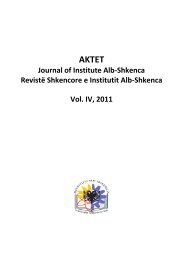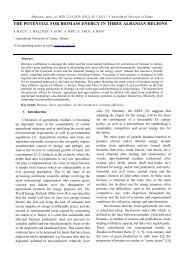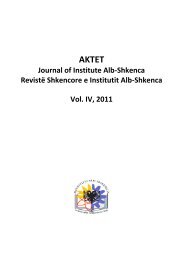Caslli et al.weight. This approach is based both on thecombination of Performances Indices method(Ashby’s method) and the Weighted PropertyIndex method, meeting the requirements ofmultiple objectives design [5].Figure 4: The chart EI-C (identification of the cheapest sections)Material - shape γ 1 γ 2 γ 3 γ 4 γ = Σγ iSection I, steel (152 x 89 x 16) 0.1 0.05 0.25 0.25 0.65Section I, aluminum (200 x 80 x 9.2) 0.16 0.11 0.05 0.08 0.40Channel U, composite (457 x 56 x 4.5) 0.25 0.25 0.06 0.14 0.70Table 2: Relative and summation performance indexes for three sectionsA weighted-property value is obtained bymultiplying the numerical value of the property(M i ) by the weighting factor i . With conditionΣ i =1, we can accept an equilibrate pondering,i.e. i = 0.25 (to minimize the effect of subjectivepreference for either one or the other objective).The individual weighted-property values of eachsection are then summed to give a comparativesections performance index, γ.γ = Σγ i (13)Accepting an equilibrate pondering, that is =0.25 (to minimize the effect of subjectivepreferences of either one or the other objective),we calculate the γ value of the groups of sectionsselected with unique objectives (&5.2).In table 2 are shown the results of calculation for“the best” factors from three different materialclasses: steel, aluminum and composites.Surveying the results, it is obvious that the steelsection “I” and the composite channel “U” arenight competitors (with light vantage for thecomposite material) with the highestperformance, while aluminum sections fallbehind the first two.6. DISCUSSION1. Four Performance Indices covering the mainfunctional and economic aspects of materialsshapeselection were considered. This shows thatmetallic sections cannot be considered theobvious solution.2. The composite sections show a strength/massratio (γ 2 ) about five times larger than analogoussteel sections, but the disadvantage can be theirouter dimensions of cross section. A similarascertainment goes for wood sections too.3. The steel “I” sections selected by the CESsoftware have dimensions in the range 127 – 152mm. While the traditional mechanical designleads to the dimension of 140 mm. The resultsare approximate, but not identical. The reasonlies in the wide values range contained in the CESdatabase [14]. More discrete information, suchas standard EN 10025:1993 is needed, and thisAKTET Vol. IV, Nr 2, 2011 205
Caslli et al.has induced us to create new database calledFOR-MAT [15].7. CONCLUSION3. The structural section selection resultsperformed by using the Ashby Method and thetraditional mechanical design method areprincipally the same: both reveal in the short listof winners, the steel profiles. However, the AshbyMethod has the advantage of quick identificationof alternative solutions too; among which are thecomposite sections. It’s important that thisoption is seen at the screening stage of selection.4. Although a large number of factors areconsidered and their relative importance is takeninto account by Weight Property Indexes duringthe application of the method, there are a lotothers which remain quite outside the possibilityof formalization. For this reason, the list ofselected candidates should not be considered asdefinitive; it can be corrected and reaffirmedafter analyzing all the factors that determine theselection.3. In order to raise the efficiency of materialshapeselection with CES software, it is necessaryto widen the Structural Sections database withmore new data from specialized EuropeanStandards. This may be a direction for furtherimprovement of this project in future.LITERATURE[1] Ashby M.F., Brechet Y., Cebon D., Salvo L.,Selection strategies for materials and processes,Materials & Design, Published by Elsevier ScienceLTD, 2003, pp. 327-333.[2] Ashby M.F., Materials Selection in MechanicalDesign, Butterworth-Heinemann, London, 2000,pp. 133-137, 228-245, 380-383.[3] Ashby M.F., Brechet, “Materials Selection fora Finite Life Time”, Advanced EngineeringMaterials, N o 6, 2002, pp. 335-341.[4] Dieter G.E., “Overview of the MaterialsSelection Process”, ASM Metals Handbook, Vol.20, ASM International, Materials Park, OH, 1997,pp. 243-253.[5] Farag M., “Quantitative Methods of MaterialsSelection”, Handbook of Materials Selection,Edited by Myer Kutz, New York, 2002, pp. 17-25.[6] Landru, D., Aides Informatisées à la Sélectiondes Matériaux et des Procédés dans la Conceptiondes Pièces de Structure, Thèse de doctorat, INPGrenoble, Janvier 2001, pp. 35-54.[7] Weaver P.M., Ashby M.F., “The optimalselection of material and section-shape”, Journalof engineering design, Vol 7, N°2, 1999, pp 129 –149.[8] Brechet Y., Bassetti D., Landru D., Salvo L.,“Challenges in materials and process selection”,Progress in Materials Science N o 46, ElsevierScience Ltd., 2001, pp. 408-413.[9] Landru D., Brechet, Y., “New Design Tools forMaterials and Process Selection”, Matériaux etTechniques, N o 9-10, 2000, pp. 31-36.*10+ Weiss V., “Computer-Aided MaterialsSelection”, ASM Metals Handbook, Vol. 20, ASMInternational, Materials Park, OH, 1997, pp. 309-314.*11+ Bourell L. (David), “Decision Matrices inMaterial Selection”, ASM Metals Handbook, Vol.20, ASM International, Materials Park, OH, 1997,pp. 291-295.[12] Pistoli V., Wood and metallic construction –calculations basis, textbook, 1975, pp. 3-10, 88,260[13] Arcelor Sections commercial S.A., Beams,Channels and merchant Bars – Sales programme;2002, IPE – IPN – HE – HL – European I beams pp.50 ÷ 68; UPE - Channels with parallel flages, pp.80 ÷ 85; L - Equal leg angles; Unequal leg angles,pp. 86 ÷100.[14] Cambridge Engineering Selector, User’smanual, published by Granta Design Limited,First edition printed, 2000, Cambrigde, UK, pp. 9-16.[15] Caslli Sh., The development of databasesand computer selection procedures in the fieldof materials (Dissertation), February 2008206AKTET Vol. IV, Nr 2, 2011






